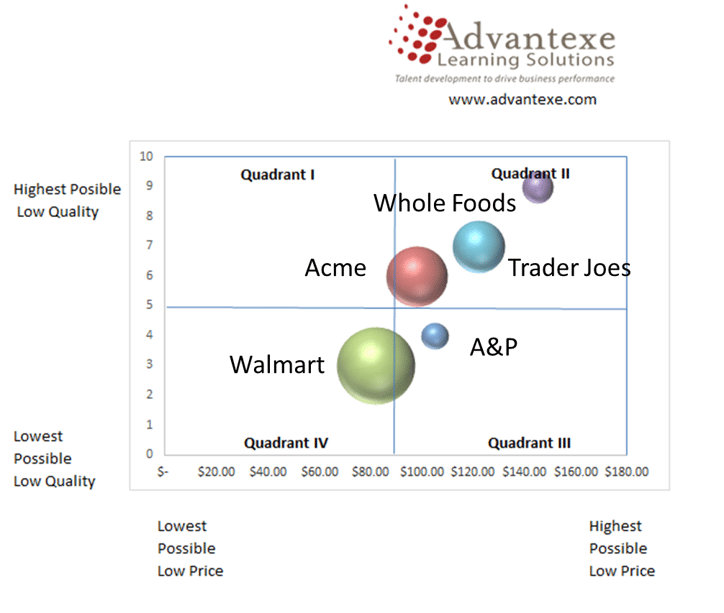
Last week brought an end to one of the most iconic brands in American industry history, The Great American & Pacific Tea Company which owned retail grocery stores under the brand names of A&P, Pathmark, Super Fresh, Waldbaums, and Food Emporium. The retail food industry is a very tough business and it can be considered a highly commoditized business. Last week, I published a blog titled “Applying an Advanced Business Acumen Perspective to Commoditized Markets” which shared new frameworks and ideas about how to compete successfully in highly commoditized markets like retail food. Sadly for consumers, the death of A&P is a story that fits into this framework and can provide interesting and useful business strategy lessons and the application of Advantexe’s Commodity Quadrant Tool which we provide to our clients and readers of this blog (Download the Commodity Quadrant Tool)
A&P started in New York City around the start of the American Civil War in 1861. What began as a small family grocery business, grew into different locations on the East Coast over a relatively short amount of time through a focus on quality and scalability, becoming a a dominant market leader into the early 1900’s. As we learn in business acumen, markets evolve quickly and a primary driver of market growth is sticking with strategy but evolving it during times of increasing competition. As A&P become more successful, new competitors tried to copy their success. With increased competition, A&P made a strategic move in 1912 when they decided to move from product leadership and innovation to a low price strategy. They purposely cut back on customer service, deliveries, and credit terms and lowered prices to drive volume. In this strategic move, “discount retail” was born.
With a new low cost / low price operational excellence strategy in place, A&P grew exponentially and by 1930 had more than 15,000 stores and revenues of over $1 billion. At the pinnacle of its success, A&P – much like Walmart today – received a tremendous amount of criticism and anger from vendors, competitors, and the community for their rigid policies that were put into place to drive costs out of their system. The Roosevelt administration sued A&P for antitrust violations and as a result of settlements and spin-offs, A&P shrunk to about 5,000 stores by 1950 but still were profitable and dominant.
But like other companies that got too complacent and didn’t continue to evolve their strategy, A&P missed a major business disruption and the 1950’s were the beginning of the end. As families moved to the suburbs, the evolution of the new suburban shopping experience started and became an entry-level expectation on the customer’s dashboard of choosing where to food shop. A&P was slow to invest money into modernizing their stores and moving to suburban locations. In addition, other modern retail grocery stores became much bigger and provided customers with more varieties and different brands at lower prices. The modern supermarket also did more innovative advertising and promotions to bring customers into the stores.
The failure to adapt and evolve the business strategy was something A&P never recovered from and finally after being in and out of bankruptcy for the past several decades, they were forced to close their doors.
So what are the business strategy lessons? I believe the most significant lesson is understanding survivability in a highly commoditized market. It is virtually impossible to survive long term and a position that has weak perceived quality and relatively higher costs.
By using the Commodity Quadrant Tool, we can see how A&P ranks versus Acme, Trader Joes, Whole Foods, and everyone’s nemeses Walmart. In this graphic, we are looking at the price and perceived quality for a typical grocery cart of the same products. The size of the circle represents relative market share how much each store sells.

Walmart has the lowest prices and the lowest perception of relative quality and are well positioned in Quadrant IV with the highest market share. Acme, Trader Joes, and Whole Foods have found a perfect alignment of relative quality and pricing for their targeted customers in Quadrant II. Whole Foods is the most expensive, has the highest quality, and has the lowest market share. And then there is the late Great Atlantic & Pacific Tea Company. They position all by themselves with inferior perceived quality at medium pricing. As we teach in our business acumen programs that use this framework, you cannot survive in Quadrants I or III.
This story and the use of the tool provide interesting lessons on strategy. Thoughts, comments, and takeaways most welcome.




